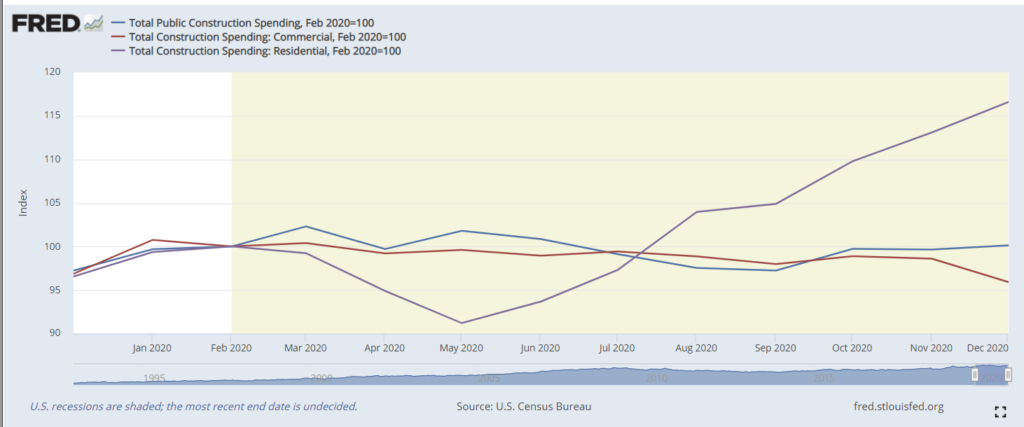Construction spending is another indicator showing a K-shaped economic recovery.
The “K” is typically associated with income. High-wage jobs are returning quicker than low-wage jobs. High net worth households are enjoying gains in wealth while poorer households struggle more than ever.
The implications of this K are important to policymakers and will affect investments. But other data shows the K extends beyond households.
Construction is also experiencing a K-shaped recovery. The chart below shows that since the recession began in February, residential construction (the purple line) increased by 16%. Government construction spending (the blue line) is flat. Commercial spending (the red line) dropped 4%.
Total Construction Spending in 2020

Source: Federal Reserve.
Construction Is an Investment in the Future
Increased residential construction shows that homeowners and builders believe homes will remain in high demand. This could be due to residents fleeing apartments for the relative safety of a larger home. Or it could be that homeowners are adding amenities to make homes more comfortable if they must quarantine again.
Governments have kept up their prior level of spending to maintain jobs in their communities. Policymakers understand the importance of this spending and avoided cutbacks.
Commercial investors have cut back on construction, indicating they are questioning what the post-pandemic economy will look like.
In some ways, this is an expected reaction to the current environment. Many commercial landlords have seen rent payments decrease as tenants struggle to remain in business.
As businesses fail, there could be less demand for commercial property. This bleak outlook for the future also explains a slowdown in commercial construction spending.
While the direction of the trend makes sense, it’s a sign of problems for the future. Commercial real estate construction drives growth in the community. The lack of investments in 2020 will slow growth in 2021, and the long-term effects will impact many communities for years to come.
Michael Carr is a Chartered Market Technician for Banyan Hill Publishing and the Editor of One Trade, Peak Velocity Trader and Precision Profits. He teaches technical analysis and quantitative technical analysis at the New York Institute of Finance. Mr. Carr is also the former editor of the CMT Association newsletter, Technically Speaking.
Follow him on Twitter @MichaelCarrGuru.




